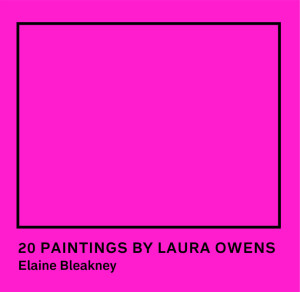20 Paintings by Laura Owens
Elaine Bleakney
Praise for 20 Paintings by Laura Owens
Bleakney's ekphrasis is by turns microscope, telescope, kaleidoscope, zoetrope.
Jesse Ball
In her brilliant 20 Paintings by Laura Owens, Elaine Bleakney invents a new form which marries abstraction and dailiness where poetry and art can converse. Distantly to Jack Spicer's disjunct footnote, here Frank O'Hara and Frank Ocean are Orphic cousins in a completely new time and place where thrive "so many colors without linebreaks."
Lee Ann Brown
Bleakney points at Owens and others -- Inger Christensen, Frank Ocean, Pavement, Hart Crane -- and calls them over, pulling them into her arms together. Maybe they'll like each other, maybe they'll even fall in love? "And then something like a map opens--a list of names." She also calls out colors, and they collect on a palette as the reader moves through the piece. "I make my orange in a place where my idea of orange is razed," she writes. She might be saying: I mix my colors in a place where colors do not exist as ideas, where they have no names. "Razed" is perfect because fire is orange. It burns itself down. "The colors aren't the same today as the day before," she writes in a poem early in the collection, and anyone who has been to the mountains knows this is true. "VOTE, the house on Pearson worries in lovesick red," she writes later, and red becomes my twisted gut on election night in 2008 or 2012, a bright red gumball stuck in my throat, the color of emergency.
Katelyn Eichwald
First of all, this is, simply put, beautiful writing. “The red. What it candles,” evokes, at least in my mind, a vivid visual response that slowly leaks into and warms the bones. (This chapbook contains a number of instances of surprising language—for example “so that texture can bleed;” “as the clouds scrape;” “she broke into candy colors,”–that ground the speaker’s associations and questions in the tangible world of the senses.) Second, getting ‘caught up in color’ is an interesting statement here. Certainly it’s appropriate to refer to color when discussing a painting. But the speaker in “20 Paintings,” arguably a work in the ekphrastic tradition, doesn’t set out to merely describe paintings, but more certainly records the moment of response.
Jenny Drai
Bleakney is chatting, voting, collaborating. She pulls Stephen Malkmus, Frank Ocean, Hart Crane into the poems. She cites La prose du Transsibérien as an influence, one of the earliest blends of abstract art and poetry, published by Blaise Cendrars and Sonia Delaunay-Terk in 1913.
20 Paintings by Laura Owens demonstrates a way to collaborate with someone you never plan to meet in real life.
The Volta Blog
Elaine Bleakney lives in Asheville, NC. Her first full-length collection of prose poems, For Another Writing Back, is forthcoming from Sidebrow in 2014. Her poetry and prose have appeared in At Length, Caketrain, Gulf Coast, Kenyon Review Online, Verse Daily, The Volta and others. She is the art editor of At Length, a place for long-form writing.
